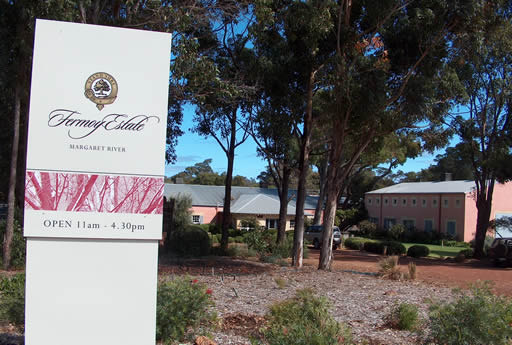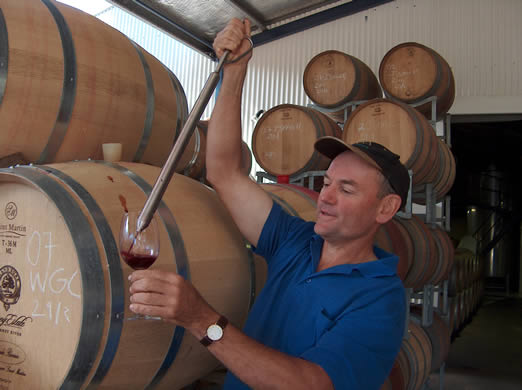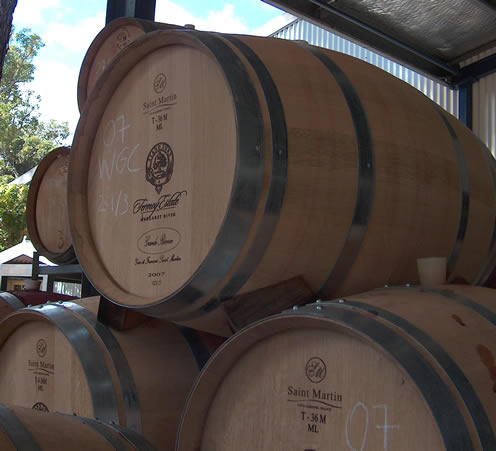|
Margaret
River, Western Australia
Part
2:
Fermoy Estate
Fermoy
Estate, PO Box 123, Cowaramup, 6284 Western Australia
Tel: +61 8 9755 6285 Fax: +61 8 9755 6251
E-mail: enquiries@fermoy.com.au
Website: www.fermoy.com.au

Fermoy
Estate was my first port of call, after having dropped Fiona and
the kids off to go on a Bushtucker kayak tour, and then driven
hastily—I was running a little late—along a deserted road
fringed with Karri gums.
Fermoy
is a small/medium-sized winery that started out with 180 cases in
1987 and is now producing 30 000 cases annually. Asia is a big
market for them: last year they sold 5000 cases to China. The
production here is based on fruit grown on their own vineyards and
a roughly equal amount of bought-in fruit.

I
met with winemaker Michael Kelly, who I quizzed on the performance
of different grape varieties in this region. ‘In Margaret River
there’s a solidness to Chardonnay, Cabernet and Semillon’, he
explained. ‘Merlot is fickle, following a biannual cycle in
quality and yield. The jury is out for Shiraz, where the yield
doesn’t seem to correlate with quality. Sauvignon Blanc is solid
but there’s a picking window of just three days or so, whereas
the others have a window of a week or two.’
Recent
history in Margaret River has been a tale of two contrasting
vintages. 2006 was the worst vintage for 20 years, and 2007 the
earliest, with the highest sugars for 15 years. There was a big
heatwave as vintage occurred. The whites were already in, but some
of the reds got raisined overnight. ‘Some people panicked and
picked early, ending up with green Cabernets’, says Kelly.
I
asked about alcohol levels. Were they on the rise? Was this a
problem? ‘The trend has been to get more phenolic ripeness in
the fruit, which invariably leads to high sugars’, revealed
Kelly. ‘Minimal additions of water are needed to bring the
alcohol levels back a bit.’ Michael added that it is possible to
do something about potential alcohol levels in the vineyard
because there is no direct correlation between yields and quality.
As a result, it’s possible with some sites to raise yield
without sacrificing quality, and in doing so harvest grapes with
lower potential alcohol levels.
 We
tried some cask/tank samples from the 2007 vintage, which had been
picked several weeks earlier and which was now finishing or had
just finished fermentation. We
tried some cask/tank samples from the 2007 vintage, which had been
picked several weeks earlier and which was now finishing or had
just finished fermentation.
1.
Sauvignon Blanc. ‘We allow 5 h skin contact, and use a bit of
barrel to help the texture. In a year like this with super high
acidity it takes the edge off’, says Kelly. The wine is
delightfully fresh and precise.
2.
Verdelho. ‘It’s our least favourite wine but it always sells
out’. They leave a
little bit of sugar in. Nice fruity style with a bit of pineapple.
3.
Wild-fermented Chardonnay. No refrigeration. This goes into the
tank, settles overnight and then to barrel. A cool room is used if
the barrels get too warm. Nice rich texture: there’s spice with
good acidity and plenty of flavour. ‘I think for wild ferments
you need to do it with new barrels,’ says Kelly.
4.
Same wine seeded with yeast, in the same type of barrel. Mixed
culture of two yeasts. Fruitier nose: rich, spicy and woody.
Michael adds that, ‘We’ve found the higher the toast, the
finer the oak becomes. We use French-coopered American oak when we
use American oak.’ 80–90% of oak used at Fermoy is French.
5.
Semillon: fresh, bright and full with a bit of woodiness.
6.
Cabernet. From one of their own vineyards. Wonderful green herby
edge to the full bright fruit. Perfumed with lovely aromas. A good
blender.
7.
Cabernet. ‘WGC’ is chalked on the barrel, standing for
‘world’s greatest Cabernet’. It’s from their best block.
Has lovely structure and weight, and is much more appealing than
the same wine in 2006, which is tight, dark savoury and showing a
bit of chocolate: a little charmless and tannic at the moment:
lacks fruit richness.
8.
Nebbiolo. Massive tannins and wonderful structure. A really
interesting wine: it’s rare to see this variety perform well
outside Piedmont.
9.
Merlot. Low vigour vineyard. Very bright and fruity. Great density
and structure with vivid fruit: superb for Merlot.
10.
Merlot. 20 year old unirrigated vines. Dark purple black.
Fantastic fruit and structure.
Then
we turned to some bottled wines.
Fermoy
Estate Semillon 2005
3000 cases made. One third is washed through barrel for a
month or two and then the reds are pressed into these barrels.
This is a nicely aromatic white that’s fresh, lemony and a bit
herby. Fresh and full on the palate with nice texture and a
pleasant herbal quality. Very good+ 89/100
Fermoy Estate Nebbiolo 2005
Not released yet: 250 cases made. Smooth deep savoury nose is
a bit chocolatey and restrained, but ripe. The palate is smooth
with nice savoury red fruits backed up by spicy tannins. It’s a
lovely savoury food wine that doesn’t shout, but which has its
own voice. Could do with a touch more perfume? Very good/excellent
90/100
Fermoy Estate Merlot 2003
Sweet, ripe chocolatey nose is ripe, supple and smooth. The
palate is sweet with nice chocolatey richness. Some structure,
too. A midweight, supple wine. Very good+ 87/100
Fermoy Estate Cabernet Sauvignon 2003
Nice spicy leafy edge to the dark fruits nose. The palate has
nice definition with lovely structure and a spicy edge to the
fruit. Savoury, dense and nicely fruited. A good Cabernet. Very
good/excellent 90/100
Wines tasted 04/07
Find
these wines with wine-searcher.com
Back
to top
|

